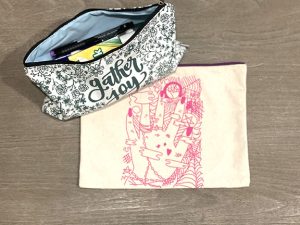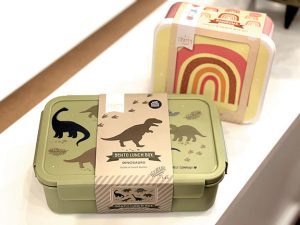
By Jody Sackett, Rumson Environmental Commission
A new school year inevitably means back-to-school shopping. But it can also be an opportunity to use your consumer power to support sustainability and minimize waste. Making environmentally-conscious choices can save money and reinforce the value of incorporating eco-friendly options into your daily life. Plus, it can be fun!
Sustainable back-to-school readiness can be structured as a series of games that kids will enjoy while enabling parents to foster a sense of environmental responsibility in their children. Even if you can only incorporate a few of these ideas into your back-to-school plan, you’ve made a great start, and every little bit helps the planet.
Remember, you’ll be achieving several impressive goals during this process. First, with landfills reaching capacity, we need to discover ways to reduce trash output. Our throw-away society is unsustainable in the long run and there is a better way. Reusing perfectly good existing school supplies is a monumental start as it saves money and stops usable items from ending up in the trash.
Additionally, reducing plastic consumption eliminates long-lasting polymers piling up for decades or centuries in the environment and waterways. Briefly using a plastic product that takes years to degrade harms both humans and the planet; less than 10% of all plastic is actually recycled. There are now many wonderful alternatives easily available that are more sustainable than plastic.
Finally, realistically assessing the whole school lunch process is a necessary chore to prevent needless food waste. First, reusable lunch containers are a great alternative to throw-away plastic bags. Second, buying food that goes uneaten is a costly habit for families that also wastes food production and transportation resources.
So, how to make back-to-school more sustainable? Let the games begin!
The Reusable Stuff Scavenger Hunt. You should know what you actually need to buy before hitting the stores so, first things first, make a list for each child. Then find them each an empty box or bin that will become their “shopping cart” for reusable school supplies. Gather the family together (perhaps on a rainy non-beach day) and give everyone half an hour to scour the house and locate leftover school supplies from last year. Parents may need to prep a bit for younger children. All found items are put in the student’s shopping cart. Focus on typical items such as backpacks, pens and pencils, notebooks, lunchboxes, scissors, pencil cases, reusable water bottles and more. Each item contributed to the shopping cart earns a point (yes, even that lowly eraser). Once everything is in the bin, carefully sort through it; if you cannot reuse it, perhaps someone else can – consider donating it to Goodwill or another charity. If you can reuse it, the contributor gets yet another point. The person with the most points gets to choose the dinner menu or skip chores for a day.

Packing lunches in reusable containers can cut back on plastic waste. Dinosaur bento and rainbow snack boxes available at Washington General Store, Red Bank. Elizabeth Wulfhorst
EcoShop Adventures. This game encourages kids and parents to compete and find the most sustainable school supplies. Now that you know what school stuff you already have, you can figure out what additional supplies you’ll need and avoid unnecessary purchases. The goal of this contest is to see who can find the most eco-friendly versions of the remaining supplies on your shopping list.
Younger children can pick out wooden pencils instead of plastic mechanical pencils at the store, or a fabric pencil case instead of one made of plastic, or even a lunchbox made of recycled materials. Older children can shop online, perhaps with parents, at websites like EarthHero or Onyx & Green, which have a wide variety of recycled and clever sustainable products like refillable pens made from recycled coffee beans, bamboo rulers, sugarcane paper notebooks, and plant-based glue. Minimizing excess packaging earns extra points.
Don’t be surprised if these products cost more than traditional ones. Durable products like reusable metal water bottles may cost more initially, but in the long run they last longer, reduce waste and could ultimately cost less since you won’t be replacing them frequently.
The winner is the student who found the greatest number of sustainable school supplies on the list and they get to choose a local outing for the family.
Remember, substituting even a few products for eco-friendly versions helps the earth and teaches children environmental values.
The Lunchbag Challenge. Residential food waste accounts for over a third of our trash, and it’s one of the easiest sources to reduce. It is no surprise to anyone that kids don’t always eat all of the lunch lovingly packed for them by well-meaning parents who want to provide a nutritional meal. But instead of sending perfectly good food that may well be discarded in the cafeteria, participants can mutually decide what the child will actually eat and pack that instead (a compromise by everyone may be needed here). The household will save money buying less food destined for the trash, the child won’t have to needlessly tote it to school, and a lot of frustration can be avoided. And why not pack lunches in eco-friendly containers to reduce polymer waste. Instead of plastic single-use sandwich and snack bags, try reusable containers or resealable silicone snack pouches easily purchased from local stores like Target, or found on Stasher and Amazon websites. They may cost a bit more now, but you can use them over and over. Metal water bottles can hold a favorite drink and there’s no residual plastics. Of course, paper love notes snuck into lunchbags by mom are always sustainable. The winner for this game? Everyone.
Incorporating sustainability awareness into our everyday lives, particularly special events like back-to-school shopping, encourages family members to make environmentally-conscious choices and realize the power consumers have, regardless of age, to act responsibly and make their voices heard. Congratulate yourself on saving money, sustainably accomplishing your shopping goals, and teaching your children the value of stewardship. You’ve achieved nirvana.
The article originally appeared in the August 17 – 23, 2023 print edition of The Two River Times.














